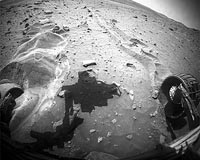 |
Copenhagen, Denmark (ESA) Dec 10, 2009 Today marks the official opening of ESA's exhibition 'Space for Earth, Understanding Climate Change from Space' at the UN Climate Change Conference, COP15, in Copenhagen, Denmark. COP15 marks a fundamental step giving politicians, decision-makers and world leaders the opportunity to discuss the most pressing environmental challenges we face today. The exhibit, hosted in partnership with the Danish Ministry for Science, is located at Kongens Nytorv in the city centre and shows how satellites are playing an important role in observing the many aspects of our ever-changing planet. Several experts spoke at the event about various aspects of space in climate change research. Showing a variety of breath-taking images of Earth from his two trips to the International Space Station in 2006 and 2009, ESA astronaut Christer Fuglesang said: "We do not realise how fragile Earth's atmosphere is, and we should all work together to preserve it." "Space for Earth is more than a smart slogan," said Peter Hulsroj, ESA Director of Legal Affairs and External Relations. "Some satellites have provided us the occasion to break the horizon and to explore Earth in a completely different fashion. Space is a very important source of information, as it helps decision-makers to find solutions which are based on facts." In his address, ESA's Head of Science, Applications and Future Technologies Department, Dr Stephen Briggs commented: "With Earth observation satellites, we can contribute to managing climate change mitigation and adaptation. It is important to base decisions from facts, and the facts can be based on satellite data." Along with a selection of invaluable data on Earth's climate, weather and environment, an impressive full-scale model of ESA's CryoSat-2 satellite to be launched next February is on display. The CryoSat mission is set to address one of the most hotly debated issues in the environmental science community: how quickly is the ice thinning? By monitoring precise changes in the thickness of the polar ice sheets and floating sea ice, CryoSat-2 aims to answer this question as well as whether the polar ice is shrinking because of global climate change. Rene Forbserg, Head of Geodynamics at Denmark's National Space Institute (DTU-Space), said: "COP15 is all about climate change, and CryoSat-2 is going to give us data about this." "Like many others, we in Denmark look forward to the launch of CryoSat-2," said Helge Sander, Danish Minister for Science, Technology and Innovation. "Denmark is also part of the ESA-led Climate Change Initiative, and I am confident that this will greatly benefit science." ESA started the Climate Change Initiative by making full use of Europe's Earth observation space assets and working with international partners to exploit robust satellite-based long-term global records of essential climate variables. The Climate Change Initiative will provide the international scientific community with a powerful tool to monitor and understand better the state of the climate system and help to predict the effects a changing climate may bring. The initiative promises to be an extremely effective mechanism for providing datasets to governing bodies for managing climate change. ESA has a vigorous Earth observation programme, which includes launching 20 satellites over the next 10 years. These include the family of Earth Explorers that will measure key Earth System processes, the Sentinels that will provide operational information services for global monitoring of the environment and security and meteorological missions. The fleet of ESA's Earth observation satellites, including ERS-1, ERS-2 and Envisat, has gathered enormous amounts of data about our planet. Archived over 30 years and increasing daily, these data will form the basis for extracting the variables most relevant to climate change and for the implementation of a follow-on Protocol should one be decided in Copenhagen. Share This Article With Planet Earth
Related Links ESA The latest information about the Commercial Satellite Industry
 Another Stall Of Right-Rear Wheel Ends Drive
Another Stall Of Right-Rear Wheel Ends DrivePasadena CA (SPX) Dec 03, 2009 Spirit's right-rear wheel stalled again on Sol 2099 (Nov. 28, 2009) during the first step of a two-step extrication maneuver. This stall is different in some characteristics from the stall on Sol 2092 (Nov. 21). The Sol 2099 stall occurred more quickly and the inferred rotor resistance was elevated at the end of the stall. Investigation of past stall events along with these character ... read more |
|
| The content herein, unless otherwise known to be public domain, are Copyright 1995-2009 - SpaceDaily. AFP and UPI Wire Stories are copyright Agence France-Presse and United Press International. ESA Portal Reports are copyright European Space Agency. All NASA sourced material is public domain. Additional copyrights may apply in whole or part to other bona fide parties. Advertising does not imply endorsement,agreement or approval of any opinions, statements or information provided by SpaceDaily on any Web page published or hosted by SpaceDaily. Privacy Statement |